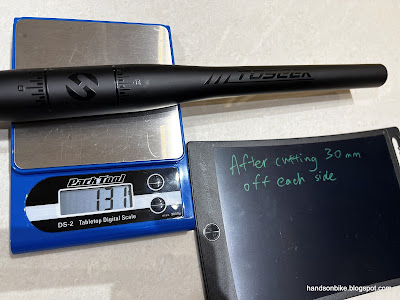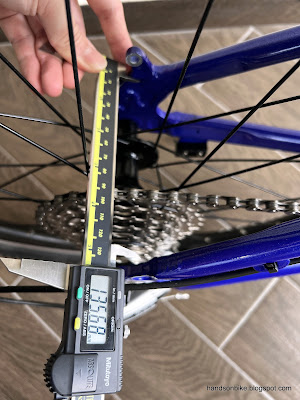One of the stock components from the Bestrider Pump Pro 20 that I considered changing was the 20 inch 406 wheelset. However, I did not order a new wheelset yet, as I wanted to see what the stock wheelset looks like. If it is good enough, I will not need to get a new wheelset.
After disassembling the bike earlier, I also removed the stock Kenda tires from the wheelset, to find out the weight of the stock wheelset.
Stock front wheel is 527 grams
Stock rear wheelset is 802 grams
The stock wheelset weight is thus 1329 grams, inclusive of rim tape. Not very lightweight, but can't complain given that it is a stock wheelset.
In comparison, the Ascent Cirrus Elite carbon wheelset is 1217 grams, while the Kinetix Pro wheelset is just 998 grams.
Rim external width is 24 mm
Rim internal width is nearly 20 mm, which is pretty good, as it is even wider than the carbon Cirrus Elite wheelset (18 mm).
Rim height is just 21 mm, which is very shallow. This helps to lower weight which is good if you are not concerned about rim aerodynamics.
Based on what I have seen so far, the weight of the wheelset is acceptable. Rim width is surprisingly wide, which helps to ensure a good tire width.
There was an issue when I fixed the front wheel onto the front fork, as the rim seems to be offset to one side. I didn't notice this earlier when the bike was fully assembled with tires.
Rim is very obviously offset to one side when installed in the front fork.
Upon closer inspection, I spotted a gap between the hub end cap and the hub shell. This does not look normal.
Whereas on the other side of the hub, the hub end cap is sunken inside the hub shell.
Based on this, it seems that the hub shell and thus the rim is not properly centered on the hub axle. Let's see if it can be fixed...
Close up look. Sealed bearing is not seated properly into the hub shell, causing it to protrude and also affect the position of the hub end cap.
On this side, the sealed bearing is seated too deep into the hub shell, causing the end cap to be sunken inwards.
After checking with the bike seller from Taobao, they said that this might be caused by the hub axle being pushed to one side during shipment. Not sure how plausible it is, but they did suggest that I could push the hub axle, to center the wheel.
No harm trying, since I got nothing to lose anyway. What I needed to do was just to find a spacer to support one side, and slowly knock on the other end.
This side needs to be pushed in
This side has to be moved outwards, which can be done by pushing on the other side.
When done properly, this is how it looks like. The sealed bearing position on both sides should look like this, so that the hub end cap positions are equal on both sides.
After reworking the front hub, the hub end cap matches properly with the hub shell on both sides as shown.
Glad that I could fix the offset front wheel myself, with a bit of DIY work. Bike seller was helpful as well, although it would be good if I did not have to fix it myself.
For the rear wheel, it comes with a freehub that supports multi speed cassettes. Since it came with a 8 speed cassette, this means that it will definitely fit a 9 speed or 10 speed cassette. 11 speed road cassettes will require longer 11 speed freehub bodies instead.
After comparing the stock rear freehub with a 11 speed freehub body, I found that they are the same length.
In other words, the stock rear wheel can support 11 speed road cassettes. If installing 8/9/10 speed cassettes, a 1.85 mm spacer is needed.
I will be using these lightweight titanium quick release levers that only weighs 51 grams per pair.
The stock wheelset is pretty OK, although it is not very lightweight. Still, it is very acceptable given that it is part of the cost of the full bike. Also, since this is for a kids bike, it doesn't have to withstand a high load or have the most efficient hubs.



















































